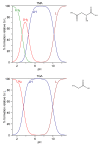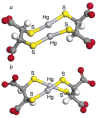A Review on Coordination Properties of Thiol-Containing Chelating Agents Towards Mercury, Cadmium, and Lead
- PMID: 31489907
- PMCID: PMC6767255
- DOI: 10.3390/molecules24183247
A Review on Coordination Properties of Thiol-Containing Chelating Agents Towards Mercury, Cadmium, and Lead
Abstract
The present article reviews the clinical use of thiol-based metal chelators in intoxications and overexposure with mercury (Hg), cadmium (Cd), and lead (Pb). Currently, very few commercially available pharmaceuticals can successfully reduce or prevent the toxicity of these metals. The metal chelator meso-2,3-dimercaptosuccinic acid (DMSA) is considerably less toxic than the classical agent British anti-Lewisite (BAL, 2,3-dimercaptopropanol) and is the recommended agent in poisonings with Pb and organic Hg. Its toxicity is also lower than that of DMPS (dimercaptopropane sulfonate), although DMPS is the recommended agent in acute poisonings with Hg salts. It is suggested that intracellular Cd deposits and cerebral deposits of inorganic Hg, to some extent, can be mobilized by a combination of antidotes, but clinical experience with such combinations are lacking. Alpha-lipoic acid (α-LA) has been suggested for toxic metal detoxification but is not considered a drug of choice in clinical practice. The molecular mechanisms and chemical equilibria of complex formation of the chelators with the metal ions Hg2+, Cd2+, and Pb2+ are reviewed since insight into these reactions can provide a basis for further development of therapeutics.
Keywords: BAL; DMPS; DMSA; metal chelator; metal ion.
Conflict of interest statement
The authors declare that they have no conflict of interest.
Figures










Similar articles
-
Metal chelators and neurotoxicity: lead, mercury, and arsenic.Arch Toxicol. 2017 Dec;91(12):3787-3797. doi: 10.1007/s00204-017-2100-0. Epub 2017 Oct 24. Arch Toxicol. 2017. PMID: 29063135 Review.
-
Chelation therapy in intoxications with mercury, lead and copper.J Trace Elem Med Biol. 2015;31:188-92. doi: 10.1016/j.jtemb.2014.04.010. Epub 2014 May 14. J Trace Elem Med Biol. 2015. PMID: 24894443 Review.
-
Dimercaptosuccinic acid (DMSA), a non-toxic, water-soluble treatment for heavy metal toxicity.Altern Med Rev. 1998 Jun;3(3):199-207. Altern Med Rev. 1998. PMID: 9630737 Review.
-
2,3-Dimercaptopropane-1-sulfonic acid and meso-2,3-dimercaptosuccinic acid increase mercury- and cadmium-induced inhibition of delta-aminolevulinate dehydratase.Toxicology. 2003 Mar 3;184(2-3):85-95. doi: 10.1016/s0300-483x(02)00575-9. Toxicology. 2003. PMID: 12499112
-
A review of pitfalls and progress in chelation treatment of metal poisonings.J Trace Elem Med Biol. 2016 Dec;38:74-80. doi: 10.1016/j.jtemb.2016.03.013. Epub 2016 Apr 9. J Trace Elem Med Biol. 2016. PMID: 27150911 Review.
Cited by
-
Blocking SIG1R Along with Low Cadmium Exposure Display Anti-cancer Qualities in Both MCF7 and MDA-MB-231 Cells.Biol Trace Elem Res. 2024 Aug;202(8):3588-3600. doi: 10.1007/s12011-023-03947-y. Epub 2023 Nov 9. Biol Trace Elem Res. 2024. PMID: 37940833
-
Effect of methylmercury on fetal neurobehavioral development: an overview of the possible mechanisms of toxicity and the neuroprotective effect of phytochemicals.Arch Toxicol. 2022 Dec;96(12):3175-3199. doi: 10.1007/s00204-022-03366-3. Epub 2022 Sep 5. Arch Toxicol. 2022. PMID: 36063174 Review.
-
Study on toxicological effect and the mechanism of cadmium in rice and inorganic cadmium on ICR mice.Toxicol Res (Camb). 2021 Jun 1;10(3):639-650. doi: 10.1093/toxres/tfab043. eCollection 2021 May. Toxicol Res (Camb). 2021. PMID: 34141178 Free PMC article.
-
Metal-free cysteamine-functionalized graphene alleviates mutual interferences in heavy metal electrochemical detection.Green Chem. 2023 Feb 7;25(4):1647-1657. doi: 10.1039/d2gc02978b. eCollection 2023 Feb 20. Green Chem. 2023. PMID: 36824602 Free PMC article.
-
Arsenic Toxicity: Molecular Targets and Therapeutic Agents.Biomolecules. 2020 Feb 4;10(2):235. doi: 10.3390/biom10020235. Biomolecules. 2020. PMID: 32033229 Free PMC article. Review.
References
-
- ATSDR . ATSDR Substance Priority List. ATSDR; Atlanta, GA, USA: 2017.
-
- World Health Organisation . Ten Chemicals of Major Public Health Concern. WHO; Geneva, Switzerland: 2010. pp. 1–4.
-
- Pearson R.G. Hard and Soft Acids and Bases. J. Am. Chem. Soc. 1963;85:3533–3539. doi: 10.1021/ja00905a001. - DOI
Publication types
MeSH terms
Substances
LinkOut - more resources
Full Text Sources

